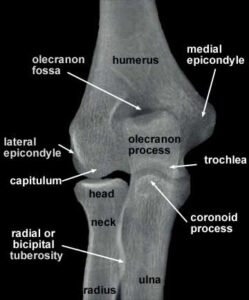Does a Normal Elbow Really Exist?
I’ve written quite a bit in the past about how diagnostic imaging (x-rays, MRIs, etc) doesn’t always tell the entire story, and that incidental findings are very common. This applies to the lower back, shoulders, and knees (and surely several other joints). The scary thing, though, is that we see these crazy structural abnormalities not just in adults, but in kids, too. Last month, I highlighted research that showed that 64% of 14-15 year-old athletes have structural abnormalities in their knees – even without the presence of symptoms. Just a month later, newer research is showing that the knee isn’t the only hinge joint affected; young throwers’ elbows are usually a structural mess as well. In an American Journal of Sports Medicine study of 23 uninjured, asymptomatic high school pitchers (average age of 16), researchers found the following:
Three participants (13%) had no abnormalities. Fifteen individuals (65%) had asymmetrical anterior band ulnar collateral ligament thickening, including 4 individuals who also had mild sublime tubercle/anteromedial facet edema. Fourteen participants (61%) had posteromedial subchondral sclerosis of the ulnotrochlear articulation, including 8 (35%) with a posteromedial ulnotrochlear osteophyte, and 4 (17%) with mild posteromedial ulnotrochlear chondromalacia. Ten individuals (43%) had multiple abnormal findings in the throwing elbow.
For me, the 35% with the osteophytes (and chondromalacia) are the biggest concern. Thickening of the ulnar collateral ligament isn’t surprising at all, but marked osseous (bone) abnormalities is a big concern.
Also, as a brief, but important aside, this study was done at the Mayo Clinic in Rochester, Minnesota – which isn’t exactly the hotbed of baseball activity that you get down in the South. Recent research also shows that players in Southern (warm weather) climates have decreased shoulder internal rotation range of motion and external rotation strength compared to their Northern (cold weather) climate counterparts. In other words, I’ll be money that the numbers reported in this study are nothing compared to the young pitchers who are constantly abused year-round in the South.
The next time you think to yourself that all young athletes – especially throwers – can be managed the same, think again. Every body is unique – and that’s why I’m so adamant about the importance of assessing young athletes. It’s one reason why I filmed the Everything Elbow in-service, which would be a great thing to watch if you’re someone who manages pitchers.
Sign-up Today for our FREE Newsletter and receive a detailed deadlift technique tutorial!




